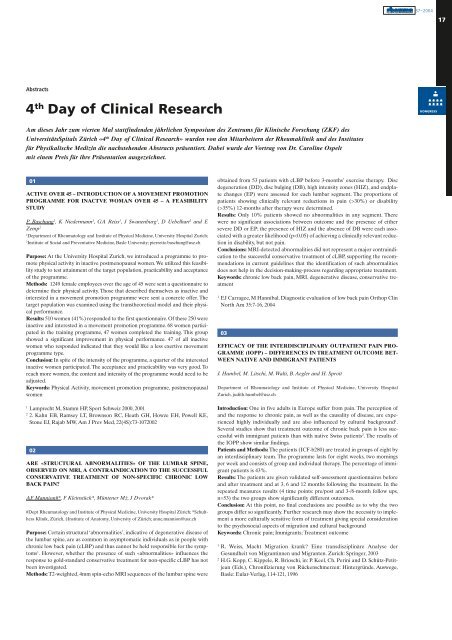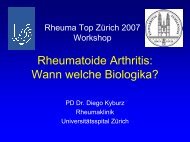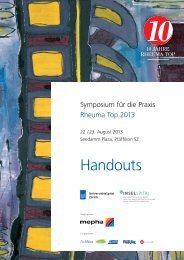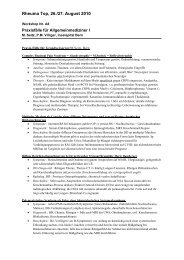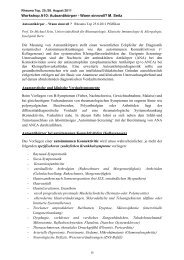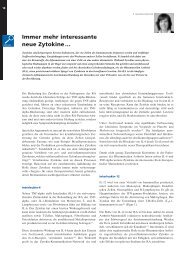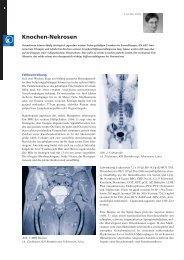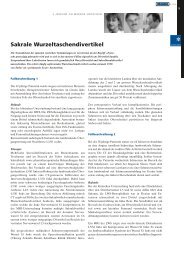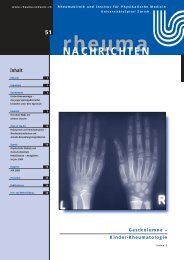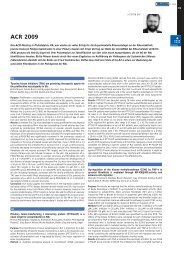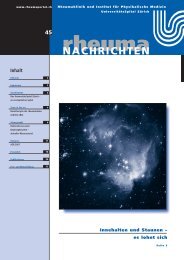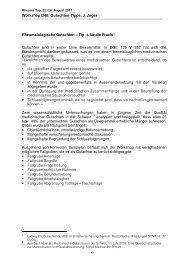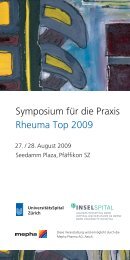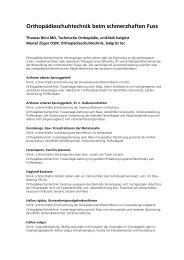Fort- und Weiterbildung in Rheumatologie und ... - Rheuma Schweiz
Fort- und Weiterbildung in Rheumatologie und ... - Rheuma Schweiz
Fort- und Weiterbildung in Rheumatologie und ... - Rheuma Schweiz
Sie wollen auch ein ePaper? Erhöhen Sie die Reichweite Ihrer Titel.
YUMPU macht aus Druck-PDFs automatisch weboptimierte ePaper, die Google liebt.
Abstracts<br />
4 th Day of Cl<strong>in</strong>ical Research<br />
Am dieses Jahr zum vierten Mal stattf<strong>in</strong>denden jährlichen Symposium des Zentrums für Kl<strong>in</strong>ische Forschung (ZKF) des<br />
UniversitätsSpitals Zürich «4th Day of Cl<strong>in</strong>ical Research» wurden von den Mitarbeitern der <strong>Rheuma</strong>kl<strong>in</strong>ik <strong>und</strong> des Institutes<br />
für Physikalische Mediz<strong>in</strong> die nachstehenden Abstracts präsentiert. Dabei wurde der Vortrag von Dr. Carol<strong>in</strong>e Ospelt<br />
mit e<strong>in</strong>em Preis für ihre Präsentation ausgezeichnet.<br />
01<br />
ACTIVE OVER 45 – INTRODUCTION OF A MOVEMENT PROMOTION<br />
PROGRAMME FOR INACTVE WOMAN OVER 45 – A FEASIBILITY<br />
STUDY<br />
P Baschung1 , K Niedermann1 , GA Reiss1 , J Swanenburg1 , D Uebelhart1 and E<br />
Zemp2 1Department of <strong>Rheuma</strong>tology and Institute of Physical Medic<strong>in</strong>e, University Hospital Zurich;<br />
2Institute of Social and Preventative Medic<strong>in</strong>e, Basle University; pierrette.baschung@usz.ch<br />
Purpose: At the University Hospital Zurich, we <strong>in</strong>troduced a programme to promote<br />
physical activity <strong>in</strong> <strong>in</strong>active postmenopausal women. We utilized this feasibility<br />
study to test atta<strong>in</strong>ment of the target population, practicability and acceptance<br />
of the programme.<br />
Methods: 1249 female employees over the age of 45 were sent a questionnaire to<br />
determ<strong>in</strong>e their physical activity. Those that described themselves as <strong>in</strong>active and<br />
<strong>in</strong>terested <strong>in</strong> a movement promotion programme were sent a concrete offer. The<br />
target population was exam<strong>in</strong>ed us<strong>in</strong>g the transtheoretical model and their physical<br />
performance.<br />
Results: 510 women (41%) responded to the first questionnaire. Of these 250 were<br />
<strong>in</strong>active and <strong>in</strong>terested <strong>in</strong> a movement promotion programme. 68 women participated<br />
<strong>in</strong> the tra<strong>in</strong><strong>in</strong>g programme, 47 women completed the tra<strong>in</strong><strong>in</strong>g. This group<br />
showed a significant improvement <strong>in</strong> physical performance. 47 of all <strong>in</strong>active<br />
women who responded <strong>in</strong>dicated that they would like a less exertive movement<br />
programme type.<br />
Conclusion: In spite of the <strong>in</strong>tensity of the programme, a quarter of the <strong>in</strong>terested<br />
<strong>in</strong>active women participated. The acceptance and practicability was very good. To<br />
reach more women, the content and <strong>in</strong>tensity of the programme would need to be<br />
adjusted.<br />
Keywords: Physical Activity, movement promotion programme, postmenopausal<br />
women<br />
1 Lamprecht M, Stamm HP, Sport <strong>Schweiz</strong> 2000, 2001<br />
2 2. Kahn EB, Ramsey LT, Brownson RC, Heath GH, Howze EH, Powell KE,<br />
Stone EJ, Rajab MW, Am J Prev Med, 22(4S):73-1072002<br />
02<br />
ARE «STRUCTURAL ABNORMALITIES» OF THE LUMBAR SPINE,<br />
OBSERVED ON MRI, A CONTRAINDICATION TO THE SUCCESSFUL<br />
CONSERVATIVE TREATMENT OF NON-SPECIFIC CHRONIC LOW<br />
BACK PAIN?<br />
AF Mannion#*, F Kle<strong>in</strong>stück*, Müntener M‡, J Dvorak*<br />
#Dept <strong>Rheuma</strong>tology and Institute of Physical Medic<strong>in</strong>e, University Hospital Zürich; *Schulthess<br />
Kl<strong>in</strong>ik, Zürich, ‡Institute of Anatomy, University of Zürich; anne.mannion@usz.ch<br />
Purpose: Certa<strong>in</strong> structural ‘abnormalities’, <strong>in</strong>dicative of degenerative disease of<br />
the lumbar sp<strong>in</strong>e, are as common <strong>in</strong> asymptomatic <strong>in</strong>dividuals as <strong>in</strong> people with<br />
chronic low back pa<strong>in</strong> (cLBP) and thus cannot be held responsible for the symptoms<br />
1 . However, whether the presence of such «abnormalities» <strong>in</strong>fluences the<br />
response to gold-standard conservative treatment for non-specific cLBP has not<br />
been <strong>in</strong>vestigated.<br />
Methods: T2-weighted, 4mm sp<strong>in</strong>-echo MRI sequences of the lumbar sp<strong>in</strong>e were<br />
obta<strong>in</strong>ed from 53 patients with cLBP before 3-months’ exercise therapy. Disc<br />
degeneration (DD), disc bulg<strong>in</strong>g (DB), high <strong>in</strong>tensity zones (HIZ), and endplate<br />
changes (EP) were assessed for each lumbar segment. The proportions of<br />
patients show<strong>in</strong>g cl<strong>in</strong>ically relevant reductions <strong>in</strong> pa<strong>in</strong> (>30%) or disability<br />
(>35%) 12-months after therapy were determ<strong>in</strong>ed.<br />
Results: Only 10% patients showed no abnormalities <strong>in</strong> any segment. There<br />
were no significant associations between outcome and the presence of either<br />
severe DD or EP; the presence of HIZ and the absence of DB were each associated<br />
with a greater likelihood (p


